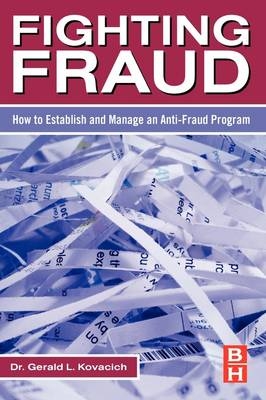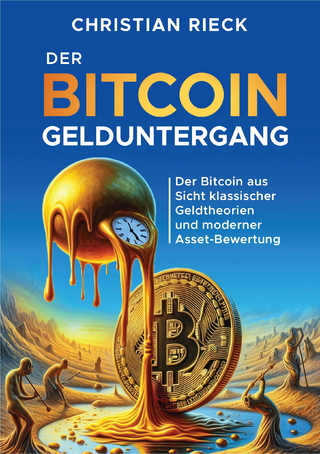
Fighting Fraud
Butterworth-Heinemann Inc (Verlag)
978-0-12-370868-7 (ISBN)
This practical reference provides the basics for instituting a corporate anti-fraud program that helps prepare corporate security professionals and other corporate managers for fighting corporate fraud from inside the company. Fighting Fraud provides an exceptional foundation for security professionals or business executives involved in developing and implementing a corporate anti-fraud program as part of a corporate assets protection program.
The author’s intent is to provide the reader with a practitioner’s guide (a “how-to book), augmented by some background information to put it all in perspective. The approach used should enable the readers to immediately put in place a useful anti-fraud program under the leadership of the corporate security officer (CSO), or other corporate professional.
Dr. Gerald L. Kovacich has more than 40 years of experience in industrial, business and government security, investigations, information systems security, and information warfare, both in the U.S. Government as a special agent, in international corporations, and subsequently as an international consultant and lecturer. He retired as the Information Warfare Technologist, Northrop Grumman Corporation to pursue a career as an international consultant, lecturer and writer.
Preface
Acknowledgments
Introduction and Premise
Section I: An Introduction To The Wonderful World of Fraud
Chapter 1 The New-Old Global Business Environment
Introduction
Globalization of Business — Benefits to Nation-States
Expansions of the Global Marketplace and their Areas of Operations
Types of Corporations
Corporate Owners and Locations
Corporate Products
The High-Technology Factor
Nanotechnology1
High-Technology Related Frauds and Other Crimes
Advent of the Superhighways4
The Impact of Superhighways on Frauds and Other Crimes
A Short History of Crimes and Other Frauds Via the I-Way
Superhighway Frauds and Other Crimes to I-Way Robberies
I-Way Robbery — Its Prevalence
There Is No I-Way Patrol to Stop I-Way Robbers
Global Connectivity Via the I-Way = Global Exposure to
Attacks by Fraud-Threat Agents and Other Miscreants
Capabilities and Limitations of Law Enforcement
Challenges to Security Professionals and Others
Case Study 1
Case Study 2
Summary
Chapter 2 Corporate Assets, Frauds and Other Terms — What are They?
Introduction
Definition of General Fraud
Specific Fraud Definitions
Corporate Assets
Other Terms and Definitions
Case Study
Summary
Chapter 3 Fraud-Related Laws
Introduction
Some U.S. Federal Fraud-Related Laws
Relevant Consumer Protection Laws for Fraud in the United States
A Few Examples of U.S. Federal Enforcement of Fraud-Related Laws, Approach and Actions
Mail Fraud Statutes (condensed and paraphrased)
Money Laundering
Financial Institution Fraud (Bank Fraud)
Civil Litigation
U.S. Treasury Collection
Securities Violations
Role of Phone Companies
European Fraud-Related Laws
EU Fight Against Frauds
ASIA and Fighting Fraud
Case Study
"Blowing the Whistle" on Defrauders can be Dangerous
Summary
Chapter 4 Corporations Don't Commit Frauds, People Do
Introduction
Are Defrauders a Product of Their Environment, or is it in Their Genes?
Some Criminology Theories
Fraud-Threat Agents
Human Errors — Accidents
Man-Made or Malicious Fraud Threats
Potential Fraud-Threat Agents
Capabilities
Motivation
Access
Catalysts
Inhibitors
Amplifiers
Fraud-Related Factors for Attacking Systems
Relationship of Threat Elements
Case Study
Summary
Chapter 5 Fighting Fraud — Whose Job is it Anyway?
Introduction
Role of Executive Management
Role of Corporate Management
Role of the Corporate Employees
Role of the Ethics Director
Role of the Auditor
Role of the Fraud Examiner
Role of the Chief Security Officer (CSO)
Why the Corporate Security Professional?
Case Study
Summary
Chapter 6 Where There is a Will There is a Way — Fraud Schemes
Introduction
Types of Fraud Schemes
Financial
Credit Card Skimming
Mortgage Frauds
Computer and Telecommunications Frauds
ATM Frauds
Click Fraud
Clip-on Fraud
Securities Frauds
Employment Application Frauds
Identity Theft Scams
"Nigerian Scam"
Accounting Fraud Schemes
Bribery and Corruption
Conflicts of Interest
Purchasing — Four Basic Categories
Inventory17
Investments and Fixed Assets
Payroll and Personal Expenses
Procurement/Contracts
Telemarketing Fraud
Advance Fee Scheme
Common Health Insurance Frauds
Letter of Credit Fraud
Prime Bank Notes
The Ponzi Scheme
Pyramid Scheme
Case Study
Summary
Chapter 7 Fraud Cases and Commentary — Learning by Example
Introduction
Actual Fraud and Fraud-Related Cases
Phishers and Taxpayers
Fraud by Corporate Executives
Foreign Exchange Trading Fraud
Katrina Waste and Frauds
Organized Crime and Cybercrime
Securities Fraud in Cyberspace
Computer Hard Drives Lead to Frauds
Debt-Collecting Frauds
Government Contracting Fraud
Fraud-Threat Agents Can Be Anyone in Any Position
U.S. Securities and Exchange Commission (SEC) Fighting Fraud
Fraud in School Systems
Dead Soldiers and E-Mail Scams
Another Example of Insider Fraud
Executive Management and Accounting Fraud
Merchandise Receipt and Exchange Fraud
Click Frauds
Mortgage Fraud
Government Contractors and Fraud
Frauds and Microsoft Software
Y2K-Related Fraud
Data Storage Conducive to Fraud-Threat Agents
Another Example of Click Fraud
Pyramid Schemes Move on to the Internet
Prepaid Cellular Phone Fraud
Identifying International Corruption
Credit Card Information Theft and Frauds
Hackers, Crackers, Phishers, Oh My!
Urban Legends and Frauds
Medical Research Frauds
Corruption and the War in Iraq
Comments on Identity Thefts as a Vehicle to Fraud
Lobbyists and Corruption
Internet Scams are International
Faking a Medical Condition
Internet Fraud Sweep
ATM Fraud
Social Security Scam
Stamp Fraud
Banker and Identity Theft
Accounting Firm Fraud
Lawyers and Medical Rip-offs
Another Mention of the "Nigerian" Scams — Variations on a Theme
Case Study
Summary
Section II: Establishing and Managing an Anti-Fraud Program
Chapter 8 The International Widget Corporation
Introduction
IWC Background Information
Key Elements for the CSO to Consider
Getting to Know IWC
IWC's Business Plan
Strategic Business Plan
Tactical Business Plan
IWC's Annual Business Plan
IWC and the History of Its CSO
Key Elements of IWC's Annual Business Plan
Anti-Fraud Program Planning
IWC's Departments of Primary Importance to the CSO
IWC Vision, Mission, and Quality Statements
Plans
Other IWC Plans and CSO Support
Case Study
Summary
Chapter 9 Establishing an Anti-Fraud Program
Introduction
IWC's Anti-Fraud Program
Anti-Fraud Program Project Planning
IWC Anti-Fraud Program Project Planning and Management
Anti-Fraud Program Project Team
Anti-Fraud Drivers — The First Major Task in Anti-Fraud Program Development
IWC Anti-Fraud Program Requirements — Policies96
Risk Assessment — The Second Major Task in Developing an Anti-Fraud Program
Basics of IWC's Risk Assessment Process97
Threats
Natural Threats
Man-Made Threats
Vulnerabilities
Risks
Assets Protection Risk Assessments
Assets Protection Risk Analyses
Developing Anti-Fraud Defenses
Three Key Ingredients in an Anti-Fraud Program's Defenses
IWC's Anti-Fraud Policies
Anti-Fraud Requirements and Policy Directive
Anti-Fraud Procedures
The CSO and Security Department's Anti-Fraud Accountabilities
Off-Site Corporate Facilities
Recruiting Anti-Fraud Professionals
Case Study
Summary
Chapter 10 Managing an Anti-Fraud Program
Introduction
CSO Leadership
Management versus Leadership
Meeting Customers' Expectations
IWC Internal Customers
IWC External Customers
IWC Executive Management Expectations of a CSO
Managing Risk
Security's Vision, Mission, and Quality Statements
Managing the IWC Anti-Fraud Program
Planning
Some Aspects to Incorporate into an Anti-Fraud Program Plan
Budgeting
Controlling
Quality, Process Improvement, and Assessment of Organization Performance
Process Management
Performance Management
Using Technology to Deliver Anti-Fraud Program Support and Services
Managing Quality and Management Oversight
What is Risk Management As It Relates to IWC's Anti-Fraud Program?
Managing and Reducing Risks to Corporate Assets
Program for Managing Anti-Fraud Defensive Risks
Responding to Fraud Incidents
Managing Fraud Threats
Case Study
Summary
Chapter 11 Winning through Teaming
Introduction
Anti-Fraud Program Team Building
Executive Management as Team Members
Teaming with IWC Executive Management Through a Business Approach
Teaming with Corporate Peers
Teaming and Dealing with Office Politics
Teaming with Your Security Managers
Teaming with Your Security Staff
Teaming and Dealing with Satellite Offices in IWC Headquarters in the United States
Teaming and Dealing with Satellite Offices in Foreign Lands
Case Study
Summary
Chapter 12 Anti-Fraud Functions
Introduction
Anti-Fraud Project Team Functional Tasks
Anti-Fraud Functions
Anti-Fraud Program's Non-Security Team Functions and Members
Case Study
Summary
Chapter 13 Are We Winning the Battle? How Do We Know?
Measure it!
Introduction
Measuring an Anti-Fraud Program's Costs, Benefits,
Successes, and Failures
Common LOE Measurement Techniques for Each Function
Examples of Metrics by Function
Investigations and NCIS Metric Chares
Examples of Anti-Fraud Investigations Metrics
Process Measurements
Case Study
Summary
Section III: The Fraudulent Future
Chapter 14 What Will the Fraudulent Future Hold for Corporations?
Introduction
Globalization of Business to Continue
Employees of the Future
The Future Global Corporation
Future of Fraud Attacks on Corporations
Future Anti-Fraud Protection Needs of Corporations
Case Study
Summary
Chapter 15 The Impact of High Technology on Fraud
Introduction
High-Technology Frauds
High-Technology Anti-Fraud Defenses
Case Study
Summary
Chapter 16 What the Security and Other Anti-Fraud Professionals Must Do Now to Personally Prepare to Combat Tomorrow's Frauds
Introduction
Becoming and Staying Proactive and Aggressive in Fighting Fraud
Getting a Fraud Education
Gaining Fraud-Related Certifications
Associations
Gaining Anti-Fraud Experience
To Conduct or not to Conduct Fraud Lectures and Write Fraud Articles
Case Study
Summary
Chapter 17 Summary and Final Thoughts
Introduction
Summary
Final Thoughts
hat Others Think About the Anti-Fraud Leadership
Position in a Corporation
Toby J. F. Bishop, CFE, CPA, FCA, President and Chief
Executive Office, Association of Certified Fraud Examiners
World Headquarters
In Conclusion-My Thoughts
Some References
End of Line
About the Author
Index
| Erscheint lt. Verlag | 5.10.2007 |
|---|---|
| Verlagsort | Woburn |
| Sprache | englisch |
| Maße | 152 x 229 mm |
| Gewicht | 570 g |
| Themenwelt | Wirtschaft |
| ISBN-10 | 0-12-370868-0 / 0123708680 |
| ISBN-13 | 978-0-12-370868-7 / 9780123708687 |
| Zustand | Neuware |
| Informationen gemäß Produktsicherheitsverordnung (GPSR) | |
| Haben Sie eine Frage zum Produkt? |
aus dem Bereich


